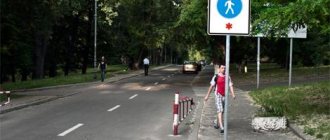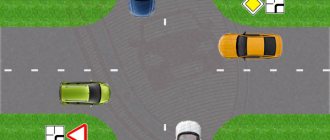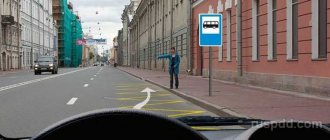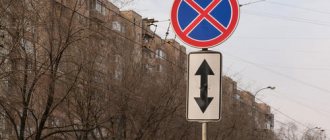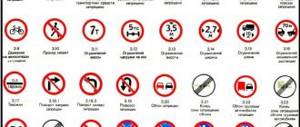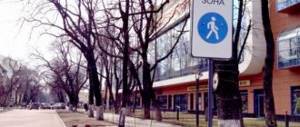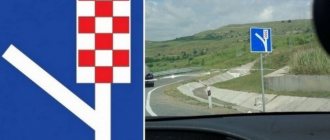Residential zone sign
A residential zone is an area whose boundaries are indicated by road signs 5.21 and 5.22.
Section 17 of the Highway Code requires a number of rules to be followed within this zone. In courtyard areas, these rules are also mandatory. Previously, the traffic rules did not contain a “Residential zone” sign, so still not every driver fully understands what is hidden under this concept, what speed is considered acceptable, and what fine will be imposed if it is exceeded. A limited area is considered residential, which is marked on both sides with appropriate signs. The traffic rules now have a whole section dedicated to driving through such territories.
The residential zone is an area whose boundaries are indicated by road signs 5.21 and 5.22
It is worth noting that in this area a pedestrian has an advantage over absolutely any vehicle.
He can walk both on the sidewalks and on the road itself, so the speed at the “Residential zone” sign should be reduced to 20 km/h. The pedestrian has an undeniable advantage over the driver, who must give way to him. True, a pedestrian also needs to be alert - there is no point in deliberately creating an obstacle in the path of a car. Even without a "Cycling" sign in this area, cyclists also have additional benefits.
Within the residential area, the same traffic rules apply as elsewhere. But others are added to them:
- Motorists are prohibited from leaving their car in a parking lot with the engine running. The engine must be turned off immediately if the vehicle is stationary for more than 5 minutes;
- a strict ban has been imposed on stopping and parking a car on the lawn;
- through traffic is strictly prohibited;
- training driving is prohibited;
- Parking of trucks weighing more than 3.5 tons is prohibited. There are special parking lots with marked spots for them.
- when moving out of this territory, the driver must give way to other vehicles;
- Maneuvering according to traffic rules is carried out only in cases of extreme necessity.
Traffic regulations requirements for traffic in a residential area
Section 17 of the traffic rules is entirely devoted to the movement of vehicles in residential areas. What requirements are imposed on the driver when driving through such areas?
1. The maximum permissible speed in a residential area is 20 km/h. The motivation for such a restriction is clear: in a residential area there is heavy traffic of pedestrians (especially minors). High speed here is a prerequisite for hitting pedestrians.
2. Pedestrians in a residential area can move not only on sidewalks or roadsides, but also along the entire width of the roadway. This requirement is justified by the fact that the residential area is actually a “sleeping area”, so pedestrians are a common occurrence here.
3. In ZhZ, pedestrians have priority in traffic, and vehicle drivers are required to give way to them. Everything is logical, but, however, there is only one exception. Pedestrians do not have the right to create unreasonable interference with vehicles.
For example, if children draw with chalk on the asphalt, then when a car approaches, they must give the driver the opportunity to pass.
Residential zone in traffic rules
A residential zone is an area whose boundaries are indicated by road signs 5.21 and 5.22. Section 17 of the Highway Code requires a number of rules to be followed within this zone. In courtyard areas, these rules are also mandatory.
A courtyard area is a space inside the perimeter formed by residential buildings, or between buildings, on which flower beds, lawns, recreation areas, children's and sports grounds are located.
The roadway located inside such a zone is primarily intended for pedestrians and cyclists; they have priority here.
The car must allow them to pass (check-in and check-out is no exception). Unnecessarily, pedestrians (cyclists) do not need to interfere with the movement of cars. The speed is limited to 20 km/h. Prohibited: instructional driving; through traffic; parking for category “C” freight vehicles; parking with the engine running.
The Administrative Code and traffic rules in courtyards and residential areas prohibit:
The roadway located inside such a zone is primarily intended for pedestrians and cyclists
- park trucks weighing more than 3.5 tons (if there is no special parking);
- park: on flower beds, lawns or areas with plantings;
- Park: on children's or sports grounds;
- Parking: on the sidewalks.
Inside a residential area, a pedestrian has legal advantages over a car. Residential or courtyard areas are not intended for the transit of vehicles.
You should only enter it if necessary:
- you live in this place;
- came to someone on business;
- you work there;
- intend to buy something;
- it is necessary to disembark a passenger or unload cargo (pick up a passenger, load cargo).
Yard area in traffic rules
Yard area (definition) is a space limited by buildings along the perimeter, inside which, as a rule, there are children's playgrounds, recreation areas, green spaces, local passages to houses, schools, kindergartens, etc.
Unlike residential areas, courtyard areas are not indicated by road sign 5.21 and do not have a network of local streets and driveways. But all restrictions on vehicle movement also apply in these territories.
There is no official definition of the term “Yard Territory” in the Traffic Regulations. But courtyards (residential areas not marked with sign 5.21) belong to the adjacent territory in which these Rules apply.
The right to a well-groomed and clean yard or basic issues of the local area
The new Housing Code established that landscaping the local area is the responsibility of the owners of the land around the house, that is, the owners of apartments in a multi-story building. Moreover, the share of participation in financing the work to clean up the site is, by law, distributed in proportion to each person’s share in the right of ownership, and such share depends on the area of the living space belonging to a particular person.
The relevant body organizes the allocation of an allotment, land surveying of the local area, preparation of technical documentation, and registration of the site for cadastral registration. After registration of a land plot, the rights to it are transferred to the owners of apartments in this building.
Traffic rules in residential areas and courtyards
The traffic rules use such terms as “residential area” and “yard area”, which includes the courtyards of apartment buildings. Traffic rules regulate traffic rules in residential areas and courtyard areas, clause 17.4, and if the rules are not followed, a fine is imposed.
What is a residential area and courtyard area?
Residential zone - an area in a populated area in which there are residential buildings, laundries, dry cleaners, baths, clinics, schools, places of worship, parking lots, garages and other objects associated with human habitation.
The boundaries of the residential area are defined by signs:
- residential zone sign 5.21 indicates the entrance to a residential zone,
- sign for residential zone 5.22 - exit from it.
Territories of courtyards and extended residential settlements also belong to residential zones.
Territories of courtyards and extended residential settlements also belong to residential zones, and accordingly, all the rules associated with residential zones will also apply to them.
Such areas may not be residential. Entry and exit signs can be placed on specific streets or sections of them in a shopping area or even a business center, since in these places it is necessary to create suitable conditions for passers-by, limiting the speed of movement, without imposing a complete ban on vehicle traffic.
A courtyard area is an area surrounded by buildings that surrounds:
- playgrounds;
- green spaces;
- places for rest;
- local driveways to houses, schools, kindergartens, etc.
Residential area and courtyard area are not always identical concepts. The boundaries of a residential zone are delineated by road signs, and there is no definition of “yard territory” in any legislative acts at all. However, signs establishing a residential zone in cities are extremely rare, so most often such zones are understood as courtyard areas.
The maximum speed in residential areas and courtyards is 20 km/h. Clause 10.2 Traffic Regulations
In residential areas it is prohibited:
- through passage (through these territories without reducing speed);
- training ride;
- stopping for more than 5 minutes with the engine running;
- parking of trucks over 3.5 tons.
In winter, motorists are tacitly allowed to deviate from these regulations when it is necessary to warm up the engine, clear the snow from the car, or clear the driveway after an overnight snowfall.
In residential areas, priority for pedestrians is established (clause 10.2 of the traffic rules). Drivers when driving in a residential area are required to give way to pedestrians, and practice driving is also prohibited. The maximum speed in residential areas and courtyards is 20 km/h. (Clause 10.2 of the Traffic Regulations).
Through traffic in a residential area is prohibited, but it is possible to avoid violating the Rules if you stop inside it and then continue driving.
When leaving a residential area or entering a residential area, the driver of the vehicle, according to the Rules, gives way to any traffic participant, regardless of the direction in which he is moving.
Disposal of the local area
The adjacent area is created for the comfort of residents - for walking, for the construction of playgrounds or parking lots, etc. However, if there are shops and offices in the house, often the entire local area is occupied by parking lots and parking lots.
But you need to keep in mind that since the entire territory around the house belongs to the owners of the premises in shares, it can only be disposed of jointly
!
- to the management company (and such a clause must be included in the management agreement);
- on the HOA (all owners of premises at a general meeting decide how the adjacent territory will be used).
The territory can even be fenced if a municipal road does not pass through the site. In this case, a public easement has been established on part of the site with the road.
.
If the road is not municipal, but belongs only to your home, you have the right at a general meeting to close your territory from unauthorized persons, for example, by installing a barrier.
Part of the site can be used profitably
, for example, rent it out for parking, and use rental payments for general house needs.
But this decision is also agreed upon between all residents
.
We should not forget that responsibility is imposed for improper maintenance of the local area. For example, a block of ice fell on a car parked near the house. The court will recover damages to the car owner:
- from the management company, if it is she who manages the house and receives payment for the maintenance of housing;
- with the HOA, if the house is managed independently (by way of recourse, the HOA can recover money paid in court from the guilty party).
Moreover, if the area where snow or ice can melt is fenced, the car owner will not receive anything if he parks the car inside the fence
.
Section 17 of the traffic rules of the Russian Federation, traffic in residential areas
In a residential area, that is, in an area whose entrances and exits are indicated by signs 5.21 and 5.22, pedestrian movement is permitted both on sidewalks and on the roadway. In a residential area, pedestrians have priority, but they should not create unreasonable interference with the movement of vehicles *(113).
The Rules give the term “residential area” a broader meaning than in urban planning practice or everyday life. This can be not only the territories of the so-called urban “dormitory” areas, but also individual streets (or sections of streets) in the business and commercial part of the city, where it is necessary to provide more favorable conditions for pedestrians, without prohibiting the movement of vehicles altogether.
The speed of movement both in residential areas and in courtyard areas should not exceed more than 20 km/h
In areas marked with signs 5.21 and 5.22, as a rule, pedestrian traffic predominates. At the same time, the movement of vehicles is sporadic and occurs along local roads and streets. Sign 5.21 operates according to the zonal principle, that is, its coverage area is limited by the “fender” sign 5.22 “End of residential area”. A driver within a “residential zone” is in all cases obliged to give way to pedestrians moving along the roadway, including outside pedestrian crossings.
In a residential area, through traffic, practice driving, parking with the engine running, as well as parking of trucks with a permissible maximum weight of more than 3.5 tons outside specially designated and marked areas *(114) are prohibited.
This paragraph sets out restrictions on the movement and parking of vehicles within the “residential zone”. It prohibits through traffic, practice driving, parking of vehicles with the engine running, as well as parking of trucks with a permissible maximum weight of more than 3.5 tons outside a special parking area.
When leaving a residential area, the driver is obliged to let both pedestrians and other vehicles pass, regardless of the direction of their movement.
The “residential zone” has the status of an area adjacent to the road in relation to the road or roads that border the “residential zone” on one or more sides (see comments on the term “adjacent territory” in paragraph 1.2 of the traffic rules). Therefore, when leaving a “residential area”, the driver is obliged to let both pedestrians and other vehicles pass, regardless of the direction of their movement.
The requirements of this section also apply to courtyard areas.
Unlike the “residential zone,” courtyard areas do not have a network of local streets and driveways. However, all of the above restrictions apply in such territories, although they are not marked with signs 5.21 and 5.22. The courtyard area should be understood as the space between residential buildings or limited along the perimeter of buildings.
Inside courtyard areas, as a rule, there are children's playgrounds, places for recreation, green spaces, local passages to houses, schools, kindergartens, etc., located in this territory. Courtyard areas are most characteristic of the so-called quarterly urban development, which has become widespread in many cities.
The speed of movement both in residential areas and in courtyard areas should not exceed more than 20 km/h (clause 10.2 of the Russian Traffic Regulations).
Standards for cleaning the territory for a janitor according to the law
Cleaning of the territory of households is carried out in accordance with the standards that are established, including for janitors. Such issues are regulated by the Resolution of the Ministry of Labor and the Order of the State Construction Committee - the documents are discussed below.
It is important to understand that the standards in each case are established by a specific organization, but they cannot contradict the norms of federal legislation. The employee must find out such information before signing an employment contract. As a rule, the table of norms is given:
10 Jun 2021 lawurist7 1559
Share this post
- Related Posts
- What is Entitled to a Military Person After 20 Calendar Years of Service
- Why Cold Water Turned Off Today Belgorod
- What benefits do labor veterans of the Smolensk region enjoy?
- Payments to single mothers forum
Residential zone in traffic rules
A residential zone is an area whose boundaries are indicated by road signs 5.21 and 5.22. Section 17 of the Highway Code requires a number of rules to be followed within this zone. In courtyard areas, these rules are also mandatory.
A courtyard area is a space inside the perimeter formed by residential buildings, or between buildings, on which flower beds, lawns, recreation areas, children's and sports grounds are located.
The roadway located inside such a zone is primarily intended for pedestrians and cyclists; they have priority here. The car must allow them to pass (check-in and check-out is no exception). Unnecessarily, pedestrians (cyclists) do not need to interfere with the movement of cars. The speed is limited to 20 km/h.
Inside a residential area, a pedestrian has legal advantages over a car. He can move along the roadway as if on a sidewalk. The driver does not have the right to signal to demand that the roadway be cleared. The pedestrian has the right of way (as does the cyclist, scooter), the driver must yield. Pedestrians also have priority when arriving and leaving.
Inside a residential area, a pedestrian has legal advantages over a car.
Residential or courtyard areas are not intended for the transit of vehicles. From the moment you entered the coverage area of sign 5.21 or any courtyard area until the moment you left (sign 5.22), you are required to follow the traffic rules established by the traffic police.
Prohibited:
- educational driving;
- through traffic;
- parking for category “C” freight vehicles;
- parking with the engine running.
The Administrative Code and traffic rules in courtyards and residential areas prohibit:
- park trucks weighing more than 3.5 tons (if there is no special parking);
- park: on flower beds, lawns or areas with plantings; on children's or sports grounds; on the sidewalks.
How is the size of the local area of an apartment building determined?
To avoid this, residents must designate this area. You can order such a procedure from cadastral companies or building managers. To do this, you will need to hold a meeting of residents, at which a corresponding decision will be made. Afterwards, minutes of the meeting are prepared, on the basis of which a service agreement will be concluded with the management company (more than 50% of the votes are required). Its specialists can carry out the property surveying procedure.
This is interesting: Compensation for Utilities in the Vologda Region
Most often, controversial situations between homeowners, homeowners associations and management companies arise due to the area of a given territory. This zone in houses built during the USSR was later privatized free of charge by all residents. In current new buildings, the size of the plot is determined by the developer at the stage of preparing the construction plan, which is enshrined in the provisions of SNiP on urban planning.
Traffic in residential areas
In the Rules, the term “Residential zone” is given a broader meaning than in urban planning practice or everyday life. This can be not only the territories of the so-called urban “dormitory” areas, but also individual streets (or sections of streets) in the business and commercial part of the city, where it is necessary to provide more favorable conditions for pedestrians, without prohibiting the movement of vehicles altogether.
There is an opinion among drivers that the rules of movement in residential areas apply only when there is a corresponding sign at the entrance to such an area - a schematic image of a house and people on a blue background (clauses 5.21 and 5.22 of the traffic rules). In fact, the rules must be followed in all internal passages and courtyards. The easiest way to distinguish a residential area from a small street or alley is by toponymy - internal passages do not have official names.
In a residential area, the speed is limited to 20 km/h (clause 10.2), and priority remains with pedestrians, who are allowed to move both on sidewalks and on the roadway. However, the rules prohibit pedestrians from intentionally obstructing traffic. Thus, if there is a sidewalk along the road, the pedestrian should move along it.
In addition, through traffic is prohibited in courtyards (although motorists like to avoid traffic jams in courtyards), practice driving, and parking with the engine running (more than 5 minutes). However, in cold weather, drivers are tacitly allowed to deviate from the parking requirement if it is necessary to warm up the engine and clear the snow from the car. Well, drivers of heavy vehicles with a curb weight of more than 3.5 tons do not have the right to park their vehicles in courtyards and residential areas.
Legal problems
- determining the size and boundaries of the PT;
- nature of use;
- management features.
The fact is that common property belongs to everyone. This means that while a person has the right to use and dispose of property, he cannot do anything alone. All decisions regarding PT are made only by a majority vote at the general meeting.
This is how the peculiarities of managing local areas manifest themselves. At the general meeting, residents decide on the placement of new facilities not included in the project, the allocation of plots for parking, landscaping, and recreational areas.
The main legal problem is determining the boundaries and area of the local area. The fact is that such territories were not allocated for houses of old construction. Yes, some buildings and courtyards did not have, there were only streets and areas like a well. Since buildings built before the nineties of the twentieth century were in state ownership, issues of development of adjacent areas were resolved at the level of local authorities.
For this reason, there are many buildings in cities that formally do not have adjacent areas. Sometimes there is simply nowhere to form them. At the same time, there is a method for calculating PT in accordance with the total area of the apartments of a given building. In order for a house to have its own official local area, property owners need to hold a general meeting (the quorum is two-thirds of the total number of owners), make a decision and contact the municipal authorities with a request to carry out land management work.
Land managers must not only determine the area of the PT, but also mark it on the ground. This will be useful for further actions on the use of land owned by the owners of the apartments of this building. After carrying out the work and receiving the technical plan, a package of documents is submitted to the Rosreestr authorities. If the applicants are denied registration of the PT as part of the property, then such a decision can be appealed in court.
Rules for placing objects
Everything that is located in the local area is a consequence of the implementation of the project, the decision of the residents of the house, or the illegal actions of people who want to benefit. After the house is built and put into operation, the so-called landscaping is carried out. The objects provided for by the project must be handed over along with the house. Everything else is finalized by the owners.
The biggest problem in the courtyards of urban apartment buildings is parking. Older houses were not designed for a large number of cars. Moreover, historical buildings were generally erected without taking into account the availability of personal transport. For this reason, when managing local areas, the organization of parking spaces is of great importance.
Who serves the territory
The fact that the adjacent territory belongs to all apartment owners does not mean that they all service it at once or in turn, although this is also possible. By decision of the general meeting, apartment owners choose a management company that not only ensures the viability of the house, but also maintains the surrounding area in proper order.
The scope of work depends on the agreement between the residents and the management company. However, usually such an organization carries out work on:
- cleaning the area;
- arrangement of recreational areas, including children's playgrounds;
- the formation of areas with green spaces;
- repairing roads in the yard;
- care of all PT facilities.
So, when choosing a management company and concluding an agreement with it, residents need to carefully consider all the points of mutual obligations.
If the local area is not allocated or some of the objects are, by force of circumstances, owned by the municipality or some department, then the general meeting or initiative group will have to interact with the management of the institutions, forcing them to take the necessary actions. If there is no provision in the agreement for maintenance, for example, of the road and sidewalks, the issue of a one-time event to pay for road repair work at the expense of the residents of the house will have to be put on the agenda of the general meeting.
This is important to know: How to privatize a garage and the land under the garage into ownership
You will have to equip the yard with video cameras yourself. To do this, you can enter into an agreement with an organization working on the “safe yard” project. The agreement can be concluded either with an individual or with the owners of several apartments. The advantages of this project are that with the help of a video camera placement system it is possible to cover almost the entire local area with round-the-clock surveillance.
Features of driving in residential and yard areas
Most drivers are not aware that a yard and a residential area have some significant differences, and there are rules for each of these concepts, so it is worthwhile to firmly understand the differences between these definitions. The traffic rules in paragraph 17.4 state that all paragraphs of this section, called “Traffic in residential areas,” are fully transferred to the wording “yard areas.”
However, the concepts themselves are not the same and these are different areas, although people live in both. There are even different visual signs to differentiate the traffic rules, which means that the residential area is different from the courtyard area. As for the concept of “yard territory”, there is simply no clear formulation and explanation in the traffic rules.
To leave courtyard areas or residential areas, there are requirements defined by traffic rules
However, the courtyard area may be included in the area of the residential area, in turn, the residential area can also be a certain part of the courtyard area. Apparently, this is why in the traffic rules, in section 17, unifying rules for both territories and zones were introduced, although this did not make the difference any clearer. But the remaining sections of the traffic rules cannot be summed up under a single line; they relate only to a certain territory, which is directly discussed in a separate paragraph of the rules.
For leaving courtyard areas or residential areas, there are requirements defined by traffic rules. When leaving the courtyard area, the driver is obliged to let anyone who is at that moment taking part in movement next to, in front of or behind the car pass. According to the current rules, clause 10.2, it is allowed to move in residential areas and courtyards at a speed of no more than 20 km/h.
According to traffic rules, driving through courtyards and residential areas in drafts is prohibited, but at the same time, who can catch you in this, if you are driving through, stop in the courtyard and, without turning off the engine, move on in 10 seconds. In this case, no one will accuse you of violating the rules and there is nothing to fine you for.
The amount of the fine varies in different regions of residence in St. Petersburg and Moscow, the amount ranges from 1,500 to 3 thousand rubles
Fines for violations in residential areas
The amount of the fine varies in different regions of residence. In St. Petersburg and Moscow, the amount ranges from 1,500 to 3 thousand rubles.
Deprivation of a driver's license occurs in case of gross violations of traffic rules - exceeding the speed of movement in a residential area up to 80 km/h. The driver's license is taken away for 12 months.
Drivers of cars and trucks must move correctly both in the yard and when leaving it. Sanctions for violation are also imposed in the absence of the 5.21 sign in the yard.
The procedure for landscaping courtyard areas
In accordance with Art. 2 of the Federal Law of 06.10.2003 N 131-FZ “On the General Principles of the Organization of Local Self-Government in the Russian Federation” (hereinafter referred to as the Law on Local Self-Government), at the level of local authorities, rules for the improvement of the territory of a municipal formation are adopted - a municipal legal act establishing on the basis of the legislation of the Russian Federation and other regulatory legal acts of the Russian Federation, as well as regulatory legal acts of the constituent entities of the Russian Federation, requirements for the improvement and elements of improvement of the territory of the municipality, a list of measures for the improvement of the territory of the municipality, the order and frequency of their implementation.
Based on the provisions of Ch. 3 of the Law on Local Self-Government, the approval of rules for improvement of the territory of a settlement is included in the list of issues of local importance of municipalities.
According to Part 1.1 of Art. 17 of the Law on Local Self-Government, the organization of improvement and approval of rules for improvement in the territories of cities of federal significance in accordance with this Law are carried out in accordance with the laws of the constituent entities of the Russian Federation - cities of federal significance.
Thus, approval of the procedure for landscaping courtyard areas is included in the list of issues of local importance.
In order to provide methodological assistance to local governments in preparing, within the framework of the exercise of powers provided for by the Law on Local Self-Government, rules for the improvement of territories, Order of the Ministry of Construction of Russia dated 04/13/2017 N 711/pr approved Methodological recommendations for the preparation of rules for the improvement of territories of settlements, urban districts, intra-city areas (hereinafter referred to as the Recommendations of the Ministry of Construction for Landscaping).
In particular, according to the Recommendations of the Ministry of Construction for Improvement:
- It is recommended to form public spaces in residential areas with a system of pedestrian communications, areas of institutions serving residential groups, microdistricts, residential areas and green areas for public use (clause 8.2);
- It is recommended to divide the territory of public spaces in residential areas into zones intended to perform certain functions: recreational, transport, economic, etc. When limiting the area of public spaces in residential areas, it is allowed to take into account functional zones and squares located within the pedestrian accessibility zone (clause 8.5);
- It is recommended that the design of landscaping of residential development sites be carried out taking into account the collective or individual nature of the use of the local area. In addition, it is recommended to take into account the features of landscaping of residential development sites when placing them as part of historical buildings, in areas of high density development, along highways, in areas under reconstruction (clause 8.8);
- It is recommended to include in the list of landscaping elements on the territory of a residential development site for collective use hard types of road surfaces, various types of site surfaces, surface interface elements, site equipment, landscaping, lighting equipment (clause 8.10).
Punishment for non-compliance with rules
Traffic rules are a mandatory set of actions for car owners of any vehicles, and are required to be followed both on the roads and in courtyard areas.
Fines:
- Failure to comply with the standards established by signs or special markings - 1,500 rubles.
- Other parking violations, including long periods of vehicle downtime - a penalty of up to five thousand rubles and evacuation to an impound lot.
- Illegal U-turn in violation of the requirements of signs and indication of the roadway - from 1000 to 1500 thousand rubles;
- Violation of the rules of stopping and parking in places designated for temporary parking or for disabled people - 5,000 rubles and evacuation.
- Parking and stopping a car on a pedestrian area, with the exception of a forced delay, violation of temporary parking on the sidewalk, if it provoked an obstacle to the movement of pedestrians - from 1000 rubles to 3000 rubles in autonomous cities.
- Exceeding the level of noise or toxicity of a car - a warning or a fine of 500 rubles.
- Failure to comply with the rules established for residential and courtyard areas is punishable by a penalty of 1,500 rubles.
- Violation of a stop, notice or penalty of 1000 rubles, in large cities 2500 rubles.
- Moscow and St. Petersburg - 3,000 rubles for violating the rules.
- In the regions, the average recovery amount is about one and a half thousand rubles.
What is prohibited in a residential area according to the rules?
The Housing Code introduces a number of restrictions and prohibitions. This is done to ensure maximum safety (especially for pedestrians).
Through traffic is strictly prohibited in residential areas.
Unfortunately, traffic regulations do not define the concept of through traffic. But, applying the principles of interpretation of law, we can say that it is a movement through the life of law without stopping and without the intention of having the goal of movement specifically in the life of life. Most often, the purpose of through traffic is the desire to shorten the route, the reluctance to participate in a traffic jam or congestion, etc.
In ZhZ, training driving is strictly prohibited.
Expert opinion
Ilyin Georgy Severinovich
Practicing lawyer with 6 years of experience. Specialization: criminal law. Law teacher.
The motive here is clear: an inexperienced driver (not even a driver yet, according to traffic regulations) in a residential area may not orient himself in time and cause harm to both pedestrians and vehicles parked closely in courtyard parking lots.
According to traffic regulations, parking of vehicles with the engine running is prohibited in a residential area.
This is an important environmental issue. The favorable human habitat is disturbed by the smell of burning, fuel and lubricants, etc. Therefore, the legislator has limited parking.
Question. Winter is coming and drivers will be faced with the problem of having to warm up the engine in severe frost. What to do if parking with the engine running is prohibited? How to combine two needs:
- Do not ruin the power unit, which can “knock” after starting to move without warming up.
- Don't break traffic rules.
It's simple. The rules prohibit PARKING the vehicle, not stopping. Therefore, to warm up the engine, the driver has at least a 5-minute head start to bring the engine temperature to operating temperature and then start driving.
According to the rules in ZhZ, it is prohibited to park vehicles with a permissible maximum weight of more than 3500 kg outside the areas indicated by signs and/or markings.
This restriction applies to parking of category C trucks. The requirement is explained:
- on the one hand, the large dimensions of such vehicles;
- on the other hand, the limited space in the residential area, which is not enough even for numerous passenger cars belonging to citizens living in the residential area.
Consequently, for parking heavy trucks, the residential area is equipped with a special area equipped with markings or signs.
